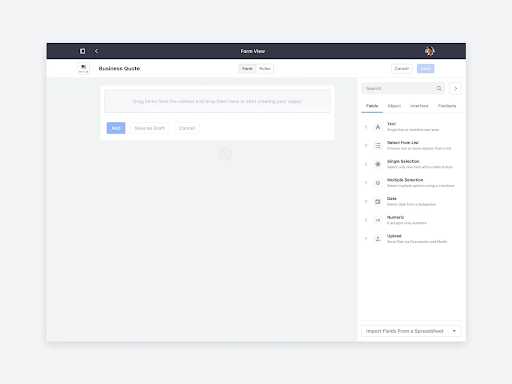In the constantly changing world of digital production, drag-and-drop app builders have become revolutionary. These tools make it easy for human beings and businesses to create, adjust, and installation apps via disposing of the requirement for in-depth coding competencies. However, not all drag-and-drop builders are made equal, given the abundance of possibilities accessible today. While some provide superficial convenience, others allow developers to create scalable, reliable, and aesthetically appealing packages. What, therefore, distinguishes the best drag-and-drop app builders in the current development market? Let’s examine in more detail the characteristics that set premium tools apart from the competition.
What Truly Sets the Best Drag-and-Drop App Builders Apart
1.User experience is prioritised with an Intuitive Interface
Any exceptional drag-and-drop app builder must have an intuitive UI that feels right at home the instant you use it. Making every operation seem smooth and intentional is more important than merely providing drag-and-drop capability. The most effective platforms foresee the demands of their users. They gently lead the user without overpowering them with complicated interfaces or technical jargon. A great interface serves both sides of the spectrum, whether the user is an experienced developer seeking speed or a novice investigating app design for the first time.
An interface that is genuinely intuitive transcends appearances. It makes complicated tasks like data integration, animations, and layout changes easier. Instead of requiring you to decipher an instruction manual, the controls need to seem instinctive, like moving pieces in a puzzle. This type of well-considered UX may prevent hours of aggravation and produce a satisfying experience that encourages users to continue developing and improving.
2.A Comprehensive Collection of Pre-Built Templates and Elements
A competent app builder is distinguished from a fantastic one by the calibre and breadth of its design assets. Buttons, forms, menus, charts, carousels, and other pre-designed user interface elements are all included in the top drag-and-drop builders. However, quantity isn’t the only factor. The final output is greatly influenced by the calibre, responsiveness, and modernism of these elements.
Another important thing to think about is templates. Industry-specific templates for e-commerce, fitness, education, healthcare, and other fields are available on top-tier platforms. These templates represent functional thinking and include features, processes, and integrations derived from industry best practices, making them more than just design shells. This lets consumers launch their projects with confidence and saves a lot of time.
3.Complexity-Free Backend Integration That Is Smooth
Although drag-and-drop builders’ front-end design is frequently their main draw, what goes on behind the scenes is just as important. Integration of back-end services, such as data storage, APIs, user authentication, and third-party tools, is shockingly simple with the top app builders. Users shouldn’t create complex logic or configuration files to gain access to these integrations.
A user should just need to click a few buttons to set up a database on Firebase, send automated emails using Mailchimp, or link their app to a Google Sheet. Visual logic builders are another feature of advanced platforms that let users create unique processes, triggers, and conditions without ever writing a line of code. The contemporary generation of app makers is characterised by this harmony between strength and simplicity.
4.Collaboration in Real Time and Cloud-Based Accessibility
Real-time collaboration may greatly increase productivity in the fast-paced workplace of today. The finest app builders facilitate cloud-based collaboration, much like Google Docs or Figma, whether a team of engineers, designers, or marketers is working together.
Numerous individuals must be able to log in, view real-time changes, leave comments on components, and roll back to earlier iterations. In professional contexts wherein revisions, comments, and approvals are an ordinary part of the workflow, this functionality is quite helpful. Furthermore, cloud-based builders guarantee that users may view their creations from any location and on any device without having to worry about program installs or file transfers. It provides a layer of adaptability that is becoming more and more necessary.
5.Integrated Device Responsiveness
Desktops are no longer the only place in the digital world. Apps are accessed by customers on wearables, devices, and smartphones, each of which has a completely unique interaction paradigm and screen size. The top drag-and-drop app builders have responsive design capabilities built in because they understand this fact. This implies that your layouts won’t require separate builds or manual tweaks to accommodate different devices.
Additionally, users may often test the app’s appearance on various screen sizes and adjust individual components as necessary. Maintaining a consistent brand presence requires that the finished product seem polished and professional across all touchpoints, which is only possible with a platform that offers this degree of device-aware design control.
6.Optimisation of Scalability and Performance
Not every software is designed to be tiny. The underlying platform must be scalable without experiencing bottlenecks as user bases and functionalities increase. This is a consideration in the design of the greatest drag-and-drop builders. They provide scalable design, effectively manage hosting, and optimise code in the background to prevent your app from stuttering under load.
These systems regularly come with abilities to track overall performance signs, such as user interaction, server reputation, and cargo times, which permits developers to see and address problems quickly. Scalability is a must for any program, whether or not it is a consumer-facing software program or an internal corporate device. Selecting a constructor who doesn’t cut corners on performance and quickness guarantees long-term success, free from unpleasant transitions down the road.
Conclusion
The drag and drop app builders are now essential tools used by producers in a variety of sectors, having transcended their novelty status. However, the requirement for judgment increases along with the market. In addition to providing visual design ease, the finest platforms offer a thoroughly integrated environment that makes it easy for users to create scalable, personalised, and functional applications. Every noteworthy element contributes to the enhancement of the creative process, from responsive design and intelligent backend connections to user-friendly interfaces and robust design libraries. Furthermore, the capacity to interact easily, expand efficiently, and iterate rapidly is no longer optional in a digital age characterised by speed and innovation—rather, it is crucial. Selecting the most visually appealing tool is not the key to selecting the best app builder. It all comes down to identifying a platform that shares its users’ values, encourages their goals, and develops with them. This is the distinction between creating something that merely functions and creating something that really shines.


